Apple iPad mini with Retina Display: Reviewed
by Anand Lal Shimpi on November 16, 2013 8:00 AM EST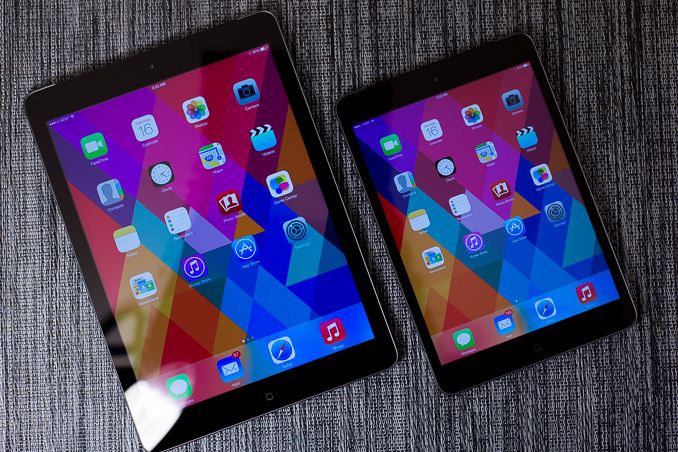
I suppose there’s only one way to start this review, and that’s by looking back at last year’s iPad mini review. In that review I had a section dedicated to the possibility of an iPad mini with Retina Display. The low resolution display and slow SoC were my only two real complaints about the first iPad mini. I listed a bunch of options that Apple had for the mini going forward:
“Apple has preferred outright quadrupling of pixel count (2x in each dimension) to create a Retina Display. With the mini's display using a 1024 x 768 resolution, this option would give it a 7.85-inch 2048 x 1536 panel. That would be the same resolution as the iPad 3/4, but in a much smaller display giving it a pixel density of 326 PPI (vs ~263 for the iPad 3/4). Apple could do this, but it would then need to make all of the same changes it made in going to the iPad with Retina Display, primarily the introduction of a larger battery and much larger SoC. The bigger battery is needed to drive the more powerful backlight, and the X-series of SoCs is needed to actually render the UI and games at such a high resolution. Both of these things would increase the size and cost of the mini, which would make it distinctly un-mini.”
What I wrote last year was more or less what Apple decided to do this year, had I stopped there I wouldn’t have ended up with egg on my face. Naturally I didn’t. At the end of that page I concluded the following:
“None of these options is particularly enticing for Apple, especially given the low (for Apple), starting price for the iPad mini. If you're expecting next year's mini to have a Retina Display, I wouldn't hold your breath.”
And this is why I don’t like making predictions.
I hadn’t expected display power to go down as much as it did. I didn’t think battery density would improve as much as it did. And I definitely didn’t think Apple would integrate a large 4MB cache on its SoCs, thereby reducing the need for a super wide memory interface. The combination of those three things made giving the iPad mini a Retina Display possible, and that’s exactly what Apple did this year.
It’s called the iPad mini with Retina Display, and unlike the iPad Air, it looks a lot like its predecessor. You’d be hard pressed to notice the 4.1% increase in thickness (+0.3mm) or the 7.5% increase in weight (+23g). Even if you did, what those slight gains net you is more than worth the effort.

From top to bottom: iPad mini, iPad mini with Retina Display, iPad Air
The Retina mini now features a 44% larger battery (23.8Wh). That’s nearly the same battery capacity as the original iPad (25Wh), but in a chassis with only 1/3 of the volume. This is also the highest capacity battery we’ve ever seen in a tablet of this size. The negligible impact on weight and thickness is pretty impressive.
The battery enables the two killer features of the new mini: mainly Apple’s A7 SoC and of course, the 7.85-inch 2048 x 1536 Retina Display. Effectively addressing my chief issues with the original iPad mini, the new mini is substantially faster and comes with a significantly better display. Keep in mind the original mini debuted with an n-1 SoC (Apple’s A5 the year the A6 came out), which makes the move to the A7 this year even more substantial of an upgrade. While casual users would be hard pressed to tell the difference between an A6 and an A7, anyone who actively used last year's iPad mini will appreciate just how much quicker the new one is (particularly if you’ve upgraded to iOS 7). It’s awesome silicon enabling a much better experience.
The display itself needs no real explanation. The first generation iPad mini featured a 1024 x 768 display, which was passable but not ideal. I had no problems recommending that mini given how good the rest of the experience was, but it’s clear that it could’ve been better. Moving to a 2048 x 1536 panel not only gives the mini the right to use the term Retina Display, but the title of highest density display in Apple’s lineup as well.
The rest of the chassis looks otherwise identical to the original mini. Apple likes to keep its mobile designs around for at least two generations, and the mini is no exception. By no means is this a complaint however. I'm just as enamored with the high quality mini chassis as I was last year. I think Apple nailed the size of the smaller iPad the first time around; 7.85-inches isn't too narrow nor is it too wide.
The face of the tablet is marked by an asymmetric bezel, identical to the iPad Air. The sides are narrow, while the top/bottom are thicker in order to accommodate the physical home button and FaceTime HD camera. Just like before, Apple does a little bit of extra work in rejecting thumbs placed on either edge of the mini to make up for the lack of side bezel to hold.
The back is a solid piece of aluminum, available in either a light silver or space (dark) grey finish. Just like with the iPhone, the silver model gets a white treatment on the front with a lighter chamfer while space grey comes with a black trim and gunmetal chamfered edge. Models with a cellular modem feature a plastic RF window along the top edge of the tablet just like the bigger iPad.
Along the edges you’ll find power/lock up top, volume up/down and a rotation lock/mute toggle on the right side. If you have a cellular model you’ll also find a nano SIM tray along the right side of the mini.
The bottom edge is home to Apple’s Lightning connector, flanked on either side by speakers. The mini sounds pretty good although you do get better low frequency reproduction out of the larger iPad Air.
The iPad mini with Retina Display features the same 5MP iSight (rear facing) and 1.2MP FaceTime HD (front facing) cameras as the iPad Air. Complementing both is a dual-mic setup for background noise removal, once again identical to the iPad Air.
The mini is available in the exact same configurations as the iPad Air. It starts at $399 with 16GB of storage, and is available in 32/64/128GB options (+$100 for each increase in storage level). Cellular connectivity is also an option, once again at a $130 adder. Just like the iPad Air, the mini with Retina Display is only available in a single LTE SKU with support for 14 different bands and ships unlocked.
| iPad Specification Comparison | ||||||||
| Apple iPad Air | Apple iPad 2 | Apple iPad mini (Retina) | Apple iPad mini | |||||
| Dimensions | 240 x 170 x 7.5 mm | 241.2 x 185.7 x 8.8mm | 200 x 134.7 x 7.5mm | 200 x 134.7 x 7.2mm | ||||
| Display | 9.7-inch 2048 x 1536 IPS | 9.7-inch 1024 x 768 IPS | 7.9-inch 2048 x 1536 IPS | 7.9-inch 1024 x 768 IPS | ||||
| Weight | 469g (WiFi) | 601g (WiFi) | 331g (WiFi) | 308g (WiFi) | ||||
| Processor | Apple A7 (2 x Cyclone 1.4GHz, PowerVR G6430) | 1GHz Apple A5 (2 x Cortex A9, PowerVR SGX543MP2) |
Apple A7 (2 x Cyclone 1.3GHz, PowerVR G6430) |
1GHz Apple A5 (2 x Cortex A9, PowerVR SGX543MP2) | ||||
| Connectivity | WiFi , Optional 4G LTE | WiFi | WiFi , Optional 4G LTE | WiFi , Optional 4G LTE | ||||
| Memory | 1GB | 512MB | 1GB | 512MB | ||||
| Storage | 16GB—128GB | 16GB | 16GB—128GB | 16GB—64GB | ||||
| Battery | 32.4Wh | 25Wh | 23.8Wh | 16.5Wh | ||||
| Starting Price | $499 | $399 | $399 | $299 | ||||
The old mini still sticks around at $299, although like the iPad 2 that’s still on sale you’d be hard pressed to hear me recommend it. Perhaps if you really don’t mind the lower resolution display, far slower SoC and want to save a little money without abandoning iOS. For most folks the iPad mini with Retina Display is where it’s at. If you’re a heavy tablet user, the experience is really night and day. While the iPad Air’s form factor is what defined its experiential improvement, the iPad mini with Retina Display relies on the display and silicon to do the same.
Weight and Usability
So much of the experience of using a tablet is tied to the weight and distribution of said weight. The iPad Air is proof of just how true that is. Whereas the iPad Air straddled the line between comfortable one and two handed usage, the mini finds itself squarely in one handed territory. Picking up the mini after using the Air for a couple of weeks feels like I’m barely holding anything. The mini is by far the more comfortable of the two tablets to hold while lying down. Sitting upright I’m not sold on the weight loss being a huge benefit compared to the mini, but if I’m relaxing the mini is just so much nicer to hold.
| iPad Dimensions/Weight Comparison | ||||||||
| iPad | iPad 2 | iPad 3/4 | iPad Air | iPad mini (Retina) | iPad mini | |||
| Height | 243 mm | 241 mm | 241 mm | 240 mm | 200 mm | 200 mm | ||
| Width | 190 mm | 186 mm | 186 mm | 170 mm | 134.7 mm | 134.7 mm | ||
| Thickness | 13.4 mm | 8.8 mm | 9.4 mm | 7.5 mm | 7.5 mm | 7.2 mm | ||
| Weight | 680 g | 601 g | 650 g | 469 g | 331 g | 308 g | ||
The chassis is narrow enough where I can just barely get one hand around the entire thing and use it like a giant smartphone. If I hold the mini in both hands like a smartphone I can actually type away super quickly using my thumbs. The latter is a use case I found myself in pretty frequently as the mini is small enough that I’d be willing to carry it with me everywhere, particularly when in a case. While the iPad Air is too big to hold in portrait mode and comfortably type on with my thumbs, the mini is too small to hold in landscape mode and use like a regular keyboard. For typing out long emails like I would on a notebook, the iPad Air is the better option assuming I can get to a desk or can sit down. If I can’t have either of those things, the iPad mini is a better companion.
Apple sent an LTE model, which basically duplicated most of the functionality of my smartphone. With the LTE mini my smartphone stayed in my pocket more, although there are tons of combinations of small/large phone/tablet that you can enumerate for optimum computing these days. In many ways it’s like the discussion between small notebook + desktop vs. large notebook + docking station.
The mini’s smaller display does make reading some content a little more difficult compared to the big iPad. Reading, particularly given the new Retina Display, is pretty good on the mini. Small text is always easier to read when it’s on a larger display, but if you’re looking at content that’s properly formatted for a tablet you’ll be in good shape on the mini. I was asked to look into the comic reading experience on the mini and also came away pretty pleased. Text bubbles were definitely not as easy to read as on the iPad Air, but overall the experience was still good in most of what I read. Ultimately you don’t sacrifice a ton of functionality if you choose the mini instead of the Air. What you do lose, you definitely make up in portability. It’s really a question of where you’re going to use the tablet that’ll determine which one to go with.
Cases
Like the iPad Air, the iPad mini is light enough that using any sort of case adds a good amount of weight to the device (percentage wise). I found myself taking the mini out of its case to use, and just keeping it protected when on the go.
Since the mini hasn’t really changed in form factor, the two first-party cases are pretty similar to what we got last year (the covers work with both mini generations). Like its bigger brother, the mini is offered with an optional Smart Cover ($39) or Smart Case ($69) depending on how much protection you want.
Apple sampled me a black Smart Cover and a Product Red Smart Case for the iPad mini. I thought both looked great on the space grey mini. It’s worth pointing out that the red Smart Case is a less saturated color than the red Smart Cover I evaluated with the iPad Air.
The Smart Cover attaches to the left side of the mini with a magnetic hinge. If you’ve lined up the magnets properly, the attractive force is strong enough to support the weight of the mini if you pick it up by the cover (though I wouldn’t recommend doing so). Magnets in the edge of the cover furthest from the hinge signal sleep/wake on the tablet itself.
The Smart Case has the same sleep/wake functionality, but instead of attaching to the mini with magnets the tablet sits inside the case for protection on both sides of the tablet. The Smart Case is what I prefer to travel with, though it is far more difficult to get in/out of and obviously adds the most weight to the device.
Both covers feature the same three fold design and can double as a stand for the tablet. Since the previous mini used the same type of cover, the angle of the stand doesn’t change like it did with the Air.
The inside surface of each cover is lined in microfiber, while the outside is made of either soft-touch polyurethane (Smart Cover) or leather (Smart Case). Both do a good job of protecting the mini and neither showed excessive wear during my review period. I still have the 1st generation mini’s Smart Cover and that one appears to have held up well over the past year.


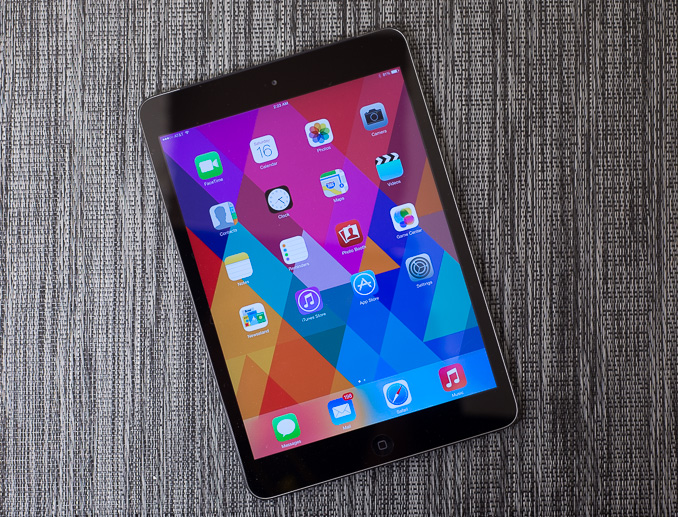
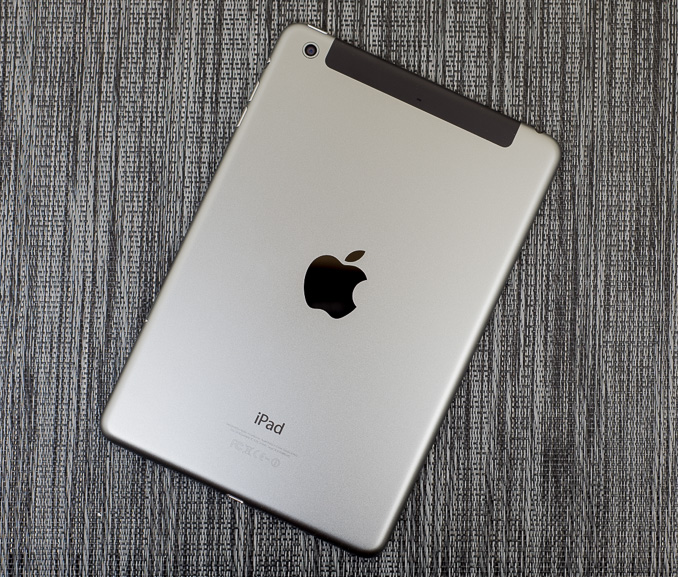
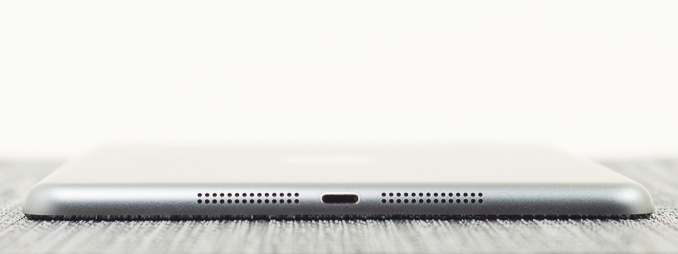






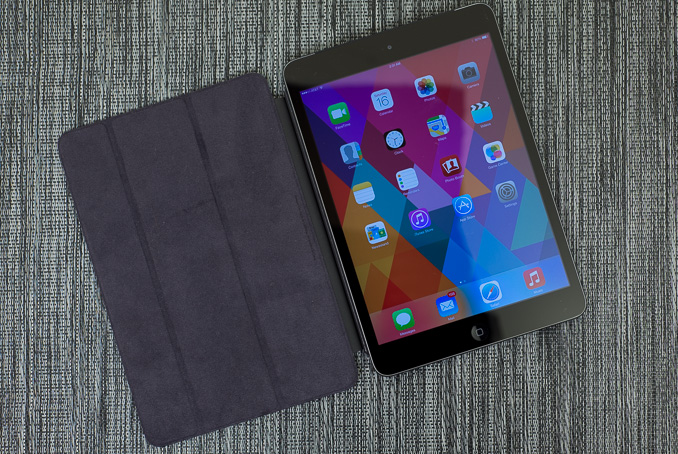
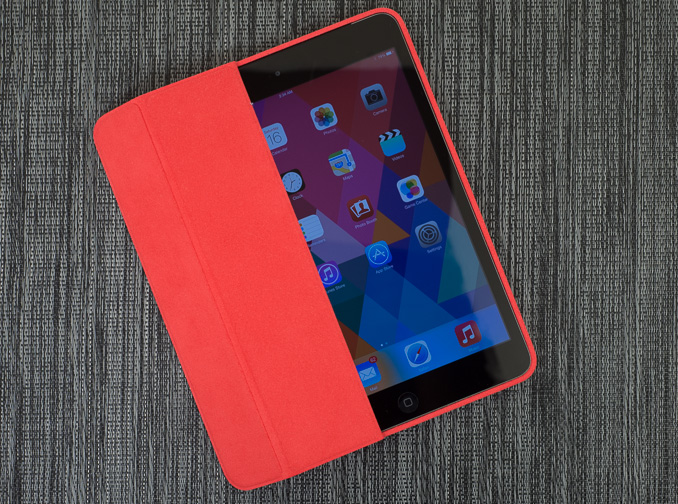









345 Comments
View All Comments
Daniel Egger - Saturday, November 16, 2013 - link
Not sure what you're referring to. I'm a WP user and I wouldn't switch to either Android (which quite frankly sucks totally in my eyes for various reasons) or iOS (because I tend to treat my phones as phone mainly and I expect nothing but the best voice quality and long standby times and best usability which quite frankly still sucks for all current smartphones but the Lumias still offer the best compromise of all -- I certainly don't need the features of an iPhone and I won't pay 4 times the price for the same value as a phone). On the other side my main workhorse is a MBP and there's no device I could be (and have been since 2001) more productive on than a Mac, I also have two iPod Touches for casual games and music and I'm looking forward to getting the new Mini as well (although I did buy a Surface RT some time ago which still really sucks for anything but Web browsing/Flash video watching and working with Office documents).Although Anand really appreciates Apple products for personal and professional I don't think this site has a particular strong bias towards them, especially given the flood of recent Android reviews by Brian that received glowing verdicts. Also there're plenty of reviews of displays reviews, windows laptops and misc hardware like PSUs, GPUs, games, etc. all of which are not in any way related to Apple products.
Scannall - Saturday, November 16, 2013 - link
The iPad is a much nicer device, and overall price is a wash. The ipad will still have great resale value in a couple years. The Nexus 7 will be a garage sale special. So upgrading will be cheaper, with the added benefit of using a better tablet.Brakken - Sunday, November 17, 2013 - link
A first time purchase seems to indicate a second time purchase. Which means spending even more money.The wonderful thing about the HTC's with dr beat and the Apple devices is great sound and (not so much for the HTC) a great music player. Android doesn't natively have such things, which means searching fro something that works. I know, I've tried.
And being at college and having to carry around a rather elongated thing that MUST have a physical keyboard for use, or a wonderfully misplacable OneNote item, seems like missing the point.
If you don't (or your daughter?) appreciate being able to whip out a device, make some notes, wherever one happens to be, and then get back to the next situation, then I'm not sure why you are bothering to cast aspersions here.
Failing to understand the pleasure of a product that was designed in a particular way, that has an integrated OS that functions remarkably smoothly (even on three year old devices!), and that such things cost more to develop and produce, simply means that Apple products are not for you (or your daughter?)
Please be aware that there are several million people who have different values, and 'nice' isn't what this review is about. It's about what the latest in SoC can achieve and the benefits of an integrated soft/hardware approach can bring. Perhaps Google/Android/Motorola/Asus/Whomever will get there one day, but not soon, I think.
melgross - Sunday, November 17, 2013 - link
Have you not considered that he switched because their products actually are better? I think so. I've used many products over the years, but have always preferred Apple's.akugami - Sunday, November 17, 2013 - link
I felt all of the important points were touched on. Anand mentions that the device is very pricey, especially compared to its closest competitor the Nexus 7 as well as other tablets. Anand also mentions flaws and I felt he touched upon any relevant ones. Lets be honest, Apple has built a very solid tablet that is arguably one of the best. It is up to the consumer to decide whether that price premium is worth buying the N7 or iPad Mini.You also mention that "Apple can do no wrong" in reference to the supposed blind love that Anand has for Apple products shows where you are coming from and shows you already have a bias against Apple. Furthermore, this is an iPad Mini review. This is not a tablet shootout. The reviewer does NOT need to compare multiple devices or even mention any other device.
Mahadragon - Sunday, November 17, 2013 - link
Apple sold 34 million iPhones in their last quarter, 9 million were sold in the opening weekend alone. Apple made $37 billion in revenue and are still the most valuable company in the world. You make it sound like the people at Anandtech are Apple fans. I have news for you, lots of people are Apple fans. Pull your head out of your behind. Apple has millions and millions of fans that buy their stuff every day.If Apple were some 2 bit company that made shoddy products then yes, I could understand your complaint about Anandtech being "biased" toward Apple products. That's not the case.
zeagus - Monday, November 18, 2013 - link
The love at AT is for well designed and performant technology. Apple nails this more often than not. The "Apple Love" here knows only the bounds of the facts. They get dinged for what they fuck up on.sundragon - Monday, November 18, 2013 - link
As an owner of the 2012 and 2013 Nexus 7 and an owner of the new iPad Air, there is a vast difference. My 2012 was replaced 3x and the 2013 was replaced once because it had an issue.You get what you pay for
2. The screen size difference between the Mini and 7 are a lot more than "almost identical" and the OS experience on a 7" display is horrible - it's not even close to being a "tablet experience" and feels like a large phone.
3. Apps on iOS look much better and are better designed than on Android - Blame the devs because it's noticeable and I have both platforms. Some games (fonts and buttons) are unusable on the Nexus 7.
4. I sold my Nexus 7 2013 because it just isn't there and I gave my 2012 to my niece and nephew.
Ultimately the comparison of specs doesn't cut it for those of us who use both platforms. Plus the A7 runs circles around the Snapdragon S4... I may come back to Google in a few years but currently the Apps and experience just aren't fully baked. That's why Samsung puts 3-4GB of bloat skin to make it "acceptable".
And before you go on about Open Source - None of the new Google apps are open source. Gmail, Calendar, Music, Movies, all the new Google apps are closed source... That's why every device is shipped with two email apps, the native android (open source that hasn't been updated in years) and Gmail. Google is slowly moving closed source for all their apps.
P.S. People comment about how awful one platform is vs the other and they don't own the device they are critiquing - Which is absurd.
Tetracycloide - Saturday, November 16, 2013 - link
The last paragraph where he still lists the display as an advantage for the mini retina even though the PPI is basically identical? Not sure if that's a good illustration of the point you're trying to make.KPOM - Saturday, November 16, 2013 - link
The iPad mini's screen is almost 43% larger with a virtually identical PPI, so in some respects it is an advantage. What amazes me is how so many Android fans harp on the iPhone's small screen size but treat a 43% screen area difference between Apple's 4x3 7.85" design and Google/Amazon's 16x9 7" design as if it's nothing.